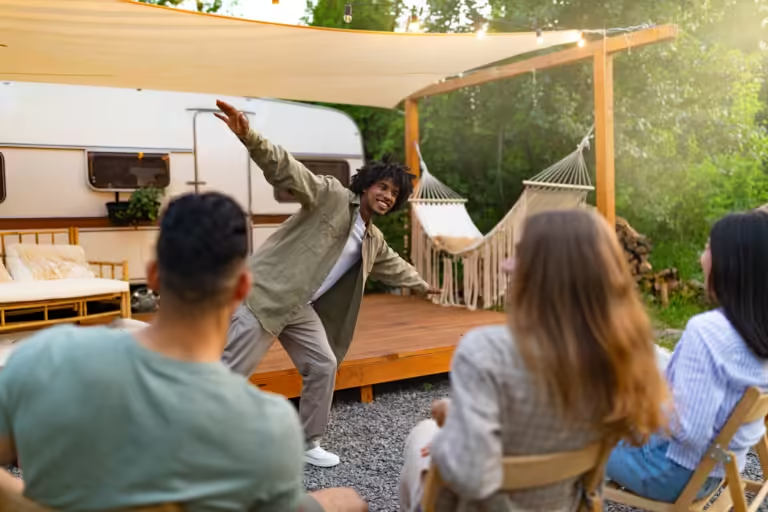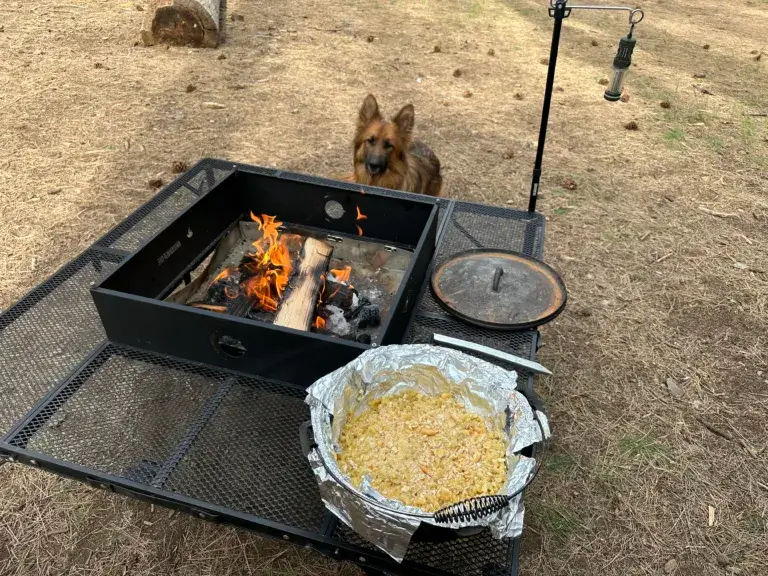Space-Saving Furniture Ideas for Small Campers: Maximize Every Inch
Living in a small camper taught me that every square inch matters. Choosing the right furniture can make or break your comfort on the road.
After years of trial and error and multiple variations and setups in my own tiny home on wheels, I’ve realized the secret isn’t about having less stuff, it’s about having smarter stuff. The key to comfortable small camper living? Pick furniture that serves multiple purposes, folds away when not needed, and squeezes the most out of your limited space without sacrificing style or function.
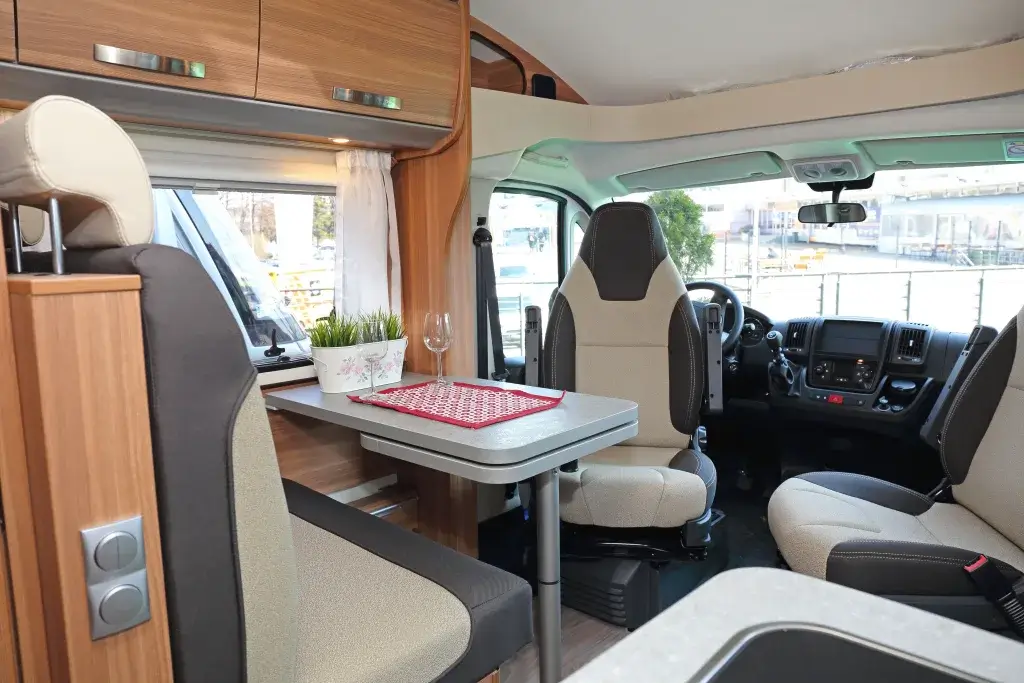
I remember my first few trips, I could barely move around because of poor furniture choices. That’s when I realized space-saving furniture solutions aren’t just helpful, they’re absolutely necessary for creating a home that actually feels livable.
From beds that transform into sofas to tables that disappear into walls, the right pieces can turn your cramped quarters into a cozy home.
Key Takeaways
- Multi-functional furniture like Murphy beds and convertible dinettes maximize space by serving more than one purpose throughout the day.
- Vertical storage solutions and hidden compartments help organize belongings without cluttering living areas.
- Smart layout design with foldable and collapsible items creates flexibility for different daily activities.
Understanding the Challenges of Small Camper Spaces

Living in a small camper made me realize the biggest hurdle isn’t just fitting everything in, it’s making sure I can actually live comfortably while doing it.
The real challenge? Working within strict physical limits while still creating a space that feels like home.
Common Space Constraints
When I first stepped into my compact camper, I quickly realized that limited counter space makes meal prep challenging. I couldn’t even chop vegetables without moving my coffee mug three times.
Storage becomes a puzzle. Every item needs a designated spot, or chaos takes over fast. I learned this the hard way when my shoes, books, and kitchen supplies started competing for the same cabinet space.
The ceiling height in most small campers hovers around 6 feet. This means I’m constantly ducking, and tall friends basically can’t visit comfortably.
Floor space disappears quickly. Once I set up my bed, table, and basic necessities, walking room shrinks to narrow pathways. It’s like playing Tetris with furniture every single day.
Bathroom facilities often feel like airplane lavatories. I’ve mastered the art of showering while barely being able to lift my arms above my head.
Balancing Comfort and Practicality
I discovered that wanting a cozy reading nook conflicts directly with needing space to cook dinner. My small camper interior design had to prioritize function over my Pinterest dreams.
Multi-purpose furniture became my best friend. My dining table doubles as a desk, workspace, and extra counter space. Without this flexibility, I’d be eating meals while sitting on my bed every night.
Temperature control gets tricky in tight spaces. When I’m cooking, the whole camper heats up instantly. Opening windows helps, but then I lose precious storage space where window coverings usually hang.
Privacy becomes creative. I use curtains and folding screens to create separate zones for sleeping, working, and relaxing. It’s not perfect, but it helps my brain switch between different activities.
Lighting plays a huge role in making small spaces feel bigger. I installed multiple light sources at different levels to avoid that cramped, cave-like feeling.
Setting Realistic Priorities
I had to get brutally honest about what I actually need versus what I think I need. That fancy espresso machine? It stayed home in favor of a simple French press that takes up one-tenth the space.
Essential items get prime real estate. My bed, cooking basics, and clothes storage earned the best spots. Everything else had to fight for leftover nooks and crannies.
I learned to embrace seasonal swaps. Summer gear goes into hard-to-reach storage when winter arrives, and vice versa. This rotation keeps daily essentials accessible.
Comfort means different things in small spaces. Instead of a full-size couch, I invested in really good cushions that work for sitting, lounging, and extra sleeping space for guests.
My biggest realization? Perfect organization isn’t the goal; functional organization is.
Multi-Functional Furniture Solutions
Multi-functional furniture transforms tiny camper spaces by serving dual purposes. A dining table becomes a bed, or seating doubles as storage.
These clever pieces maximize every square inch while keeping your mobile home comfortable and organized.
Convertible Beds and Sofas
I’ve discovered that convertible dinettes are absolute game-changers in small campers. During the day, I use mine as comfortable seating for meals and relaxation.
When bedtime arrives, I simply remove the table and rearrange the cushions to create a cozy sleeping area.
Here’s what makes them work:
- High-density foam cushions provide comfort for both sitting and sleeping.
- Built-in storage underneath benches holds bedding and essentials.
- Easy conversion process takes just minutes.
Sofa beds offer another smart solution. I love how they maintain a living room feel during the day while providing a proper mattress at night.
The key is choosing one with a sturdy frame that won’t sag over time.
Pro tip: Look for models with memory foam mattresses. They’re lighter, more comfortable than traditional spring systems and take up less space when folded.
Storage Ottomans and Benches
My storage ottoman has become my favorite piece of multi-functional furniture. It serves as extra seating when friends visit, a footrest after long driving days, and hidden storage for blankets and games.
I particularly appreciate ottomans with storage because they solve multiple problems at once. Inside mine, I keep:
- Extra throw pillows
- Board games for rainy days
- Emergency supplies
- Seasonal clothing
Upholstered benches work similarly but offer more seating capacity. I’ve seen clever campers use them as dining seating that stores dishes and cookware underneath.
Choose wisely: Pick ottomans with removable tops for easy access. Fabric options add warmth, while leather or vinyl handles spills better.
Futons and Murphy Beds
Murphy beds absolutely maximize floor space during daytime hours. When folded up, mine creates an entire living area where my bedroom used to be.
It’s like having two rooms in one tiny space.
The installation was straightforward, and now I have a desk area that transforms into a bedroom each night. Some models even include built-in storage or fold down to reveal a desk surface.
Futons offer a simpler alternative. Mine doubles as both couch and guest bed without requiring wall mounting.
The frame folds flat, and the mattress serves as back cushions during the day.
Consider these factors:
- Weight capacity for safety
- Ease of operation (especially important in tight spaces)
- Mattress quality for comfortable sleep
I’ve found that investing in quality mechanisms pays off; cheap hardware fails quickly with frequent use.
Clever Table Choices for Compact Living
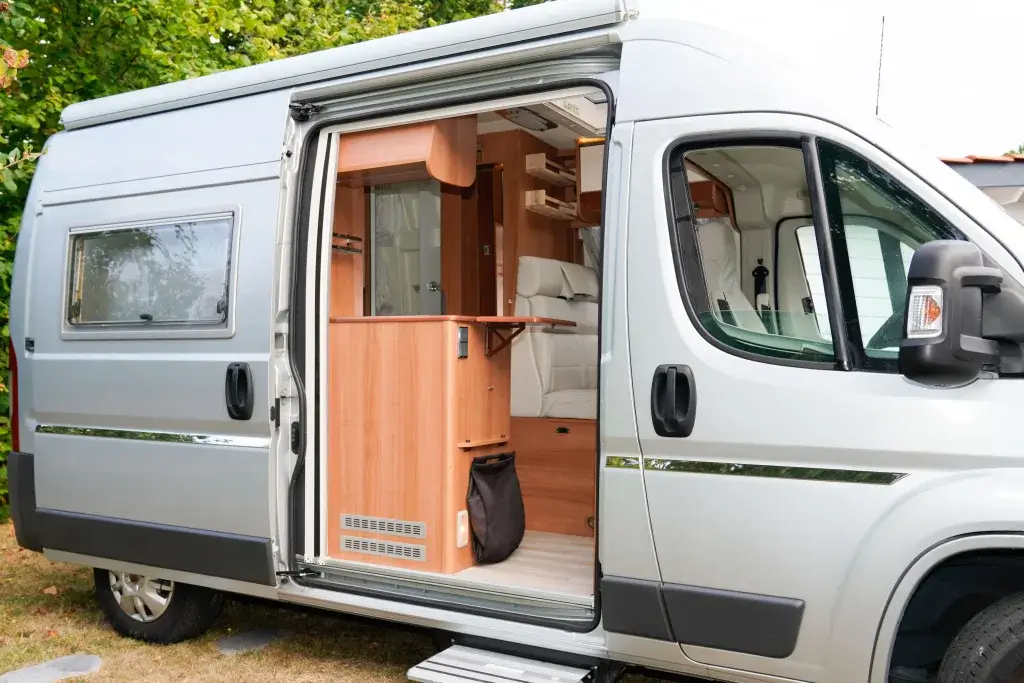
Tables in small campers need to work harder than their house-bound cousins. The best options fold away when not needed, store your gear inside them, or mount to walls to free up precious floor space.
Fold-Out Tables for Dining and Work
I’ve found that fold-out tables are absolute game-changers in tiny camper spaces. These clever pieces attach to walls or cabinet sides and swing out when you need them.
My favorite setup uses a sturdy wooden fold-out that doubles as both dining space and laptop desk. When it’s meal time, I flip it down and suddenly have room for four people to eat comfortably.
The beauty lies in their dual-purpose design. During the day, I use mine as a work surface for my computer. At night, it becomes our dinner table.
When we’re done, it folds flat against the wall.
Installation is straightforward. Most fold-out tables use heavy-duty hinges that can support 50-75 pounds. I mounted mine to a structural wall stud for maximum stability.
Expandable console tables work similarly but offer even more versatility. They can transform from slim accents to full-sized dining surfaces.
Look for models with locking mechanisms to prevent accidental folding. Nothing ruins dinner faster than a wobbly table that won’t stay put!
Adaptable Coffee Tables with Storage
Coffee tables with built-in storage have saved my sanity more times than I can count. These multitasking marvels give you a surface for drinks and snacks while hiding clutter inside.
I chose one with lift-top functionality that reveals a spacious compartment underneath. It holds board games, extra blankets, and all those random items that used to scatter around our small space.
Ottoman-style coffee tables work brilliantly too. Mine has removable cushions on top for extra seating when friends visit.
The hollow interior stores camping gear that we don’t use daily.
Some models feature drawers on the sides or shelving underneath. These give you easy access to frequently used items like remote controls, magazines, or charging cables.
The key is choosing the right height. I learned this the hard way, too low and it’s awkward to use, too high and it dominates the room.
Nesting tables offer another smart solution. You can tuck smaller tables under the main one when space gets tight.
Wall-Mounted Desks
Wall-mounted desks are a secret weapon for creating workspace without losing living space. These ingenious solutions fold down when needed and disappear when not.
I installed mine in what used to be dead wall space near the dinette. The fold-down design means it takes up zero floor area when closed, but provides a full desk surface when open.
Murphy desk systems work similarly to Murphy beds. They fold up into a cabinet that looks like regular wall storage. Inside, you can organize office supplies and keep everything tidy.
The installation requires finding wall studs for proper support. I used heavy-duty brackets rated for at least 100 pounds to handle my laptop, books, and occasional coffee spills.
Floating desk shelves offer a simpler alternative. These permanent fixtures provide a narrow work surface that doesn’t interfere with traffic flow through your camper.
Some wall-mounted solutions include built-in storage cubbies or small drawers. These keep pens, papers, and other work essentials within easy reach.
The best part? You can position them at the perfect height for comfortable typing and reading.
Maximizing Vertical and Hidden Storage
Smart vertical solutions and hidden compartments can transform unused spaces into valuable storage areas. These strategies help you store more items without cluttering your living space or adding bulk to your camper’s weight.
Overhead Compartments and Bunk Storage
If you’re short on space in your camper, don’t overlook the area above your head. Overhead compartments along the ceiling have been a lifesaver for me.
They’re perfect for stashing seasonal clothes, extra bedding, and those “just in case” items you don’t need every day. I stick to shallow, lightweight compartments so things don’t get lost up there.
Clear bins are my go-to; they make it easy to spot what’s inside. No more digging around in the dark corners.
Bunk areas are another goldmine for hidden storage. The space under a top bunk is just begging for a few vertical wire baskets for shoes and odds and ends. Here’s a DIY vertical storage idea that’s worked well for me.
I built simple cubbies into the sides of the bunks. Each person gets their own little nook for books or personal stuff, which means fewer arguments about whose socks are whose.
Making these spots easy to reach is huge. I pop in small LED lights so I’m not groping around for my flashlight at midnight.
Floating Shelves for Small Essentials
Floating shelves are my not-so-secret weapon for keeping things tidy without crowding the floor. I love squeezing them into those awkward gaps between furniture or along walls that would otherwise just collect dust.
In the kitchen, floating shelves hold spices, oils, and the random gadgets I can’t live without. I mount them above the stove, close enough to grab, but not in the way.
The bathroom gets the same treatment. Floating shelves keep my toiletries off the counter, and I never have to deal with bulky cabinets.
Got a weird little gap next to the fridge? That’s prime real estate for a skinny shelf; mine holds my coffee stash.
If you’re adding shelves, use sturdy mounting hardware. I always screw into wall studs, not just drywall, so things don’t go flying when I hit a pothole.
Keep heavier stuff on the lower shelves. Higher up, I stick to paper goods or plastic containers; no one wants a can of beans falling on their head.
Hidden Drawers and Tucked-Away Compartments
Hidden storage is a game-changer. I built drawers under my dinette bench, slide them out, and bam, there’s all my linens, tools, and gear.
Don’t forget the space under your stairs. I installed pull-out drawers there, too. One holds cleaning supplies, another’s packed with games and rainy-day activities.
I got creative with a false floor. There’s a hidden compartment under the floorboards for important papers, emergency cash, and backup electronics (all in waterproof containers, of course).
The toe kick under my kitchen cabinets hides flat stuff perfectly. I cut little access panels for cutting boards and folding tables.
Even door panels can be sneaky storage spots. I mounted shallow boxes inside cabinet doors for spices and small tools. They swing open with the door, so everything’s easy to grab but stays out of sight.
Optimizing Camper Layout and Interior Design
If you want your small camper to feel bigger than it is, you’ve gotta get creative with the layout. Smart planning and a few design tricks can turn a cramped box into a cozy home on wheels.
Open floor plans, clever color choices, and seating that adapts to your life make all the difference. I’ve tried it all, some things worked, some didn’t, but the winners opened up my space.
Open Floor Plans and Free-Flowing Zones
Knocking out unnecessary walls made my camper instantly feel roomier. Instead of boxing off each area, I let the spaces flow into each other.
My dining table pulls double duty as a workspace. It swings down from the wall when I need it, then tucks away to free up space.
Here are a few zoning tricks I swear by:
- Kitchen counter that stretches into the dining area
- Bedroom that opens up to the living room during the day
- Bathroom door that slides instead of swinging out
Efficient layouts for tiny trailers work best when everything has more than one job. My bed lifts up to reveal storage, and my kitchen island rolls wherever I need it.
When you blur the boundaries, magic happens. Instead of three tiny rooms, I have one big, flexible space that changes with my day.
Color and Lighting Tricks for a Spacious Feel
Light colors help a small space feel bigger. I painted my walls in soft white with a hint of gray, and suddenly my camper felt twice as big.
Here’s my go-to color palette:
- Walls: Warm white or light cream
- Accents: Soft blues or sage greens
- Furniture: Natural wood tones
LED strip lights under cabinets and along the ceiling edges create a “floating light” effect. No more dark corners or harsh shadows.
Mirrors are pure magic. I put one across from the main window; it bounces natural light around and makes the space feel deeper.
Switching to bright, airy camper designs with translucent window coverings was a game-changer. Heavy curtains made my camper feel like a cave, but light-filtering shades keep things private and bright.
Glossy surfaces reflect light better than matte ones. My kitchen backsplash is just simple subway tile with a bit of shine, but it makes the whole room feel lighter.
Flexible Seating Arrangements
Flexible seating totally changed how I use my space. My main seating area is all modular cushions that I can move around for dining, lounging, or even entertaining (when I’m feeling sociable).
Bench seating along one wall has removable cushions. By day, it’s a comfy spot for four people. At night, I take off the back cushions, and it becomes part of my bed.
Some seating solutions I love:
- Ottoman with hidden storage for extra seating
- Folding chairs on wall hooks
- Swivel captain’s chairs that turn to face wherever I need
My dining booth transforms into a lounge by pulling out the table and piling on throw pillows. I’m never stuck with just one setup.
Bar-height seating at the kitchen counter saves floor space. The stools slide under the counter when I’m done, so I can move around without tripping.
Personal Touches and Practical Decor
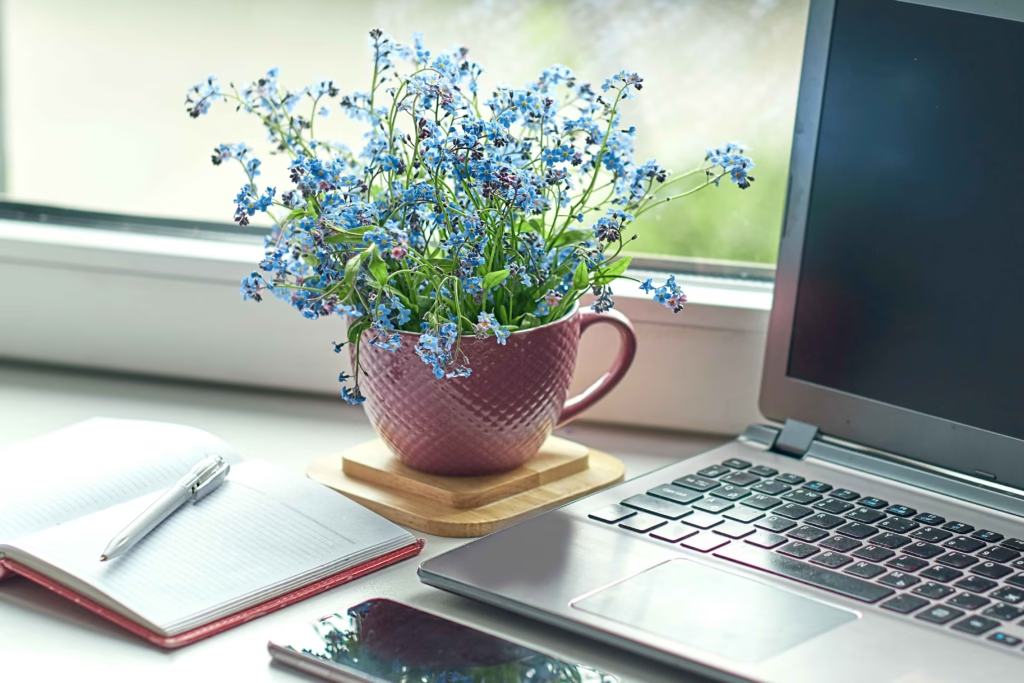
To make your camper feel like home, pick decor that works hard and shows off your style. Smart entryway ideas, storage-friendly decorations, and a few clever accessories can make a huge impact without crowding your space.
Functional Entryway Features
Your entrance sets the vibe for your whole camper. If you get it right, you’ll keep dirt out and make the most of every inch.
Wall-mounted coat hooks are a must for jackets and bags. I hang them at different heights so everything fits without blocking the door.
A slim shoe rack that slides under a bench keeps shoes in check. Mine fits four pairs and disappears when I’m not using it.
| Feature | Space Used | Storage Capacity |
|---|---|---|
| Over-door organizer | 0 floor space | 6-8 small items |
| Fold-down bench | 12 inches | 2-3 pairs boots |
| Magnetic key holder | Wall space only | Keys, sunglasses |
I put a small mirror by the door for a quick check before heading out. Bonus: it makes the entry feel a bit bigger.
Mudmats that fold flat are essential. I shake them out and stash them in a skinny cabinet when they’re dry.
Decor That Doubles as Storage
My favorite camper decor is the kind that does more than look pretty. Functional decor lets you show off your taste and keep things practical.
Woven baskets hang on my walls and hold everything from toiletries to snacks. I stick to natural colors that match my style.
Mason jar organizers aren’t just cute, they’re super useful. I mount them inside cabinet doors for spices, craft supplies, or random bits and bobs.
Decorative boxes stack nicely on shelves and hide clutter. My vintage ones are stuffed with charging cables, first aid stuff, and all those little things that never have a home.
Throw pillows with hidden zippers are genius. Mine hide extra blankets and add a pop of color to my seating area.
Floating shelves show off my favorite books and plants, but keep surfaces clear. I pick shelves with hidden brackets for a clean look.
Creative Use of Accessories
Accessories in a small camper need to earn their keep. Over the years, I’ve found a few tricks that add personality and keep things tidy.
Magnetic spice containers stick to my range hood and double as quirky decor. I label them with chalkboard paint for a fun, coordinated look.
String lights aren’t just for ambiance; they’re my go-to for reading in bed. The solar-powered ones are perfect and set a cozy mood.
Pegboards turn blank walls into useful art. I hang hooks, baskets, and even tiny plants so the display changes with my needs.
Vintage-style tins serve as both decoration and storage. They hold tea, tools, or art supplies and add some character to open shelves.
Command strips let me swap out artwork whenever I want. I keep a small stash of lightweight prints to match my mood or the season.
Plants bring life to the camper. I stick with hardy types like pothos or snake plants; they don’t mind a little travel.
Frequently Asked Questions

Living small comes with a lot of questions. I’ve tried every trick in the book for squeezing more out of my space, and I’m happy to share what’s worked (and what hasn’t).
What are some clever multi-purpose furniture pieces for a compact camper lifestyle?
My convertible dinette is a total lifesaver. By day, it’s a table and benches; by night, it flips into a bed. The bench seats lift up to reveal huge storage spaces.
Ottomans with hidden storage are a must. I use mine as extra seating, a footrest, and a place to stash pillows and blankets.
Multi-functional furniture like benches with storage does double duty for seating and gear. My folding table expands when I need it and disappears when I don’t.
Swivel seats are a brilliant fix for tiny spaces. They help me switch from driving to dining to lounging without feeling boxed in.
Can you share creative DIY storage solutions for limited space in small RVs?
Wall-mounted hooks have saved me more times than I can count. I hang everything, pots, jackets, towels, even my favorite mugs. Magnetic hooks work wonders on metal surfaces, too.
I built pull-out drawers inside my stairs. It sounds wild, but now that dead space holds all my shoes and cleaning stuff.
Under-bed storage is pure gold. Raising my bed gave me a garage-like space for bulky gear and suitcases.
Hidden storage compartments under the couch or inside an ottoman are great for extra bedding and gear.
Pegboards are my organizing secret. I can rearrange hooks and baskets as needed, so everything stays tidy and close at hand.
What are the best ways to organize clothing in a tiny camper to maximize space?
Packing cubes changed everything for me. I roll my clothes and tuck them into cubes that stack neatly.
Cabinet door organizers are perfect for socks, underwear, and the little things that always seem to get lost.
Vacuum storage bags are magic for seasonal clothes. My puffy winter gear shrinks down to nothing when I don’t need it.
Under-bed bins keep off-season clothes nearby but out of the way. I label them so I don’t end up digging through mystery bins.
A simple wardrobe rod across the back of my camper keeps shirts wrinkle-free and easy to grab. Sometimes the simplest solutions work best.
Could you suggest any unique interior modifications to help create more room in my travel trailer?
Mirrors are like tiny space-expanding wizards! I stuck mirrored surfaces on cabinet doors and hung a few decorative mirrors around, and suddenly the whole place felt twice as big.
Foldable and extendable table systems like the Lagun table are a game-changer. You get a dining or work spot when you need it, and it disappears completely when you’re done.
I went for a Murphy bed that folds up against the wall during the day. With the bed out of the way, there’s so much more room for yoga, stretching, or just pacing around with your coffee.
Ceiling-mounted storage nets are surprisingly handy. They hold lightweight stuff like pillows and blankets, and they don’t eat up your precious cabinet space.
Sliding barn doors are a real space saver compared to traditional ones. Plus, they add that cozy, rustic vibe and don’t swing out and block your path.
What exterior storage hacks can make life on the road with a small camper more manageable?
My rear cargo box keeps all my outdoor gear out of the living area. No more tracking mud inside or tripping over boots.
I added a bike rack that moonlights as a gear hauler. When the bikes stay home, it carries my camp chairs and folding table.
Side-mounted storage pods work great for tools and maintenance gear. I love having everything organized and easy to grab when something needs fixing.
My awning creates instant outdoor living space. It’s like tacking on a bonus room, no extra weight, no fuss.
Roof-mounted storage is perfect for awkward, bulky items like sleeping bags and camping chairs. I just toss them up there and reclaim my interior space for the important stuff, like snacks.
How might one reconfigure a small camper layout to enhance the overall feeling of spaciousness?
Segmented spaces can really change the vibe inside a tiny camper. Using curtains or foldable dividers, I create little zones for sleeping, dining, or just lounging, no need for clunky, permanent walls.
Light colors work wonders. I went with white walls and picked out pale fabrics for cushions and curtains. Everything instantly felt airier, almost like I’d snuck in an extra window or two.
If you’re tripping over extra furniture, it might be time to let some of it go. I ditched a bulky chair and just use my bed as a seat during the day. It’s a simple swap, but wow, the floor space I got back!
Lighting is more powerful than you’d think. For tasks, I’ve got bright LED overheads, but when I want to wind down, I switch to softer lamps. It’s cozy and practical, a win-win.
Tall, narrow cabinets are my secret weapon for storage. They pull your gaze up and make the ceiling seem higher. If you’re short on space, think vertical instead of spreading out.



